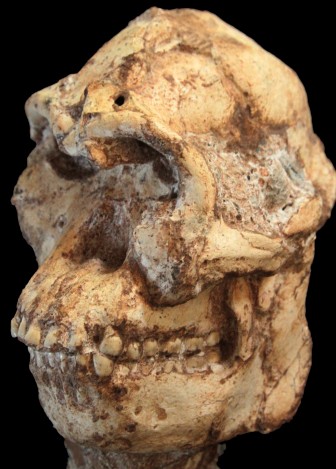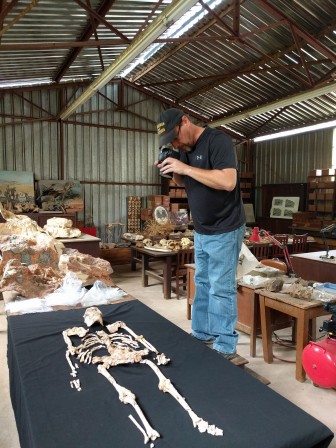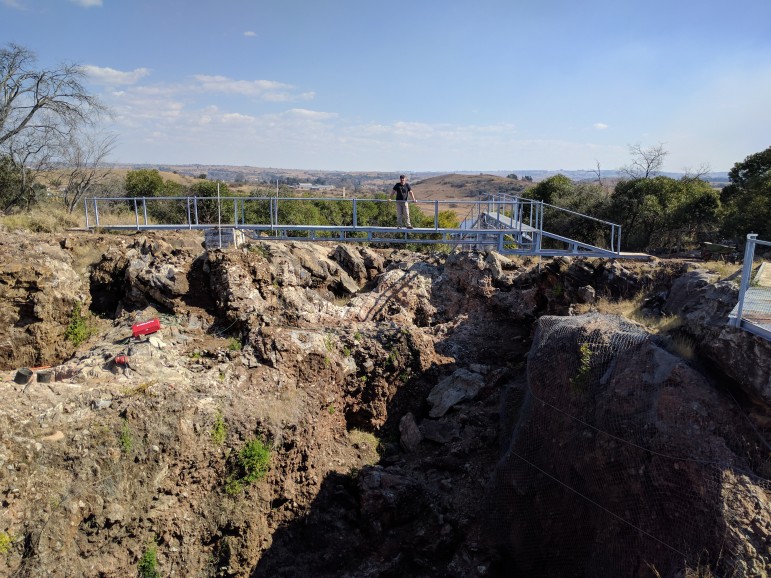“Astonishing” Find Could Be New Pre-Human Species
Last month, scientists in South Africa revealed “Little Foot,” a three-million-year-old pre-human skeleton that could tell us a lot about ourselves. A Birmingham-Southern College scientist is helping to analyze this potential new species, but before we tell you about the present, let’s take you back … a little.
It’s the 1920s. Miners are blasting away in huge caves near Johannesburg. Shattered rocks litter the scene. Some have fossils in them, but the miners don’t care.
Now jump to the 1990s. A researcher named Ron Clarke finds some of those remains in boxes at a university. There were tiny foot bones – that’s where the name “Little Foot” comes from – and a tibia, or a shin bone. People had thought they were from cows, but Clarke saw otherwise.
“He noticed on a tibia that it was broken at the very top – it was a fresh break,” says Birmingham-Southern College anthropologist Jason Heaton. “He asked two of our fossil preparators if they would go and find – in this gigantic, underground, dark cave – a cross-section of that bone. And so they took handheld lamps, and within two days, they found the cross-section, and they were able to find out exactly where Little Foot’s skeleton was.”
Battling some very stubborn rock, Clarke and his team eventually dug out one of the oldest and most complete hominid skeletons ever found. They’ve dated Little Foot at about 3.67 million years – at least as old as the famous “Lucy” skeleton from east Africa. And Little Foot is almost 90 percent whole, compared to Lucy’s 40 percent.
“The reason Little Foot is going to be so dramatically important to what we do is the fact that it’s so complete,” says Heaton, “because when you look at early human prehistory, we only have 10 or 11 partial skeletons.”
That’s because smaller, more delicate bones usually don’t last millions of years, even when they haven’t been chewed up by carnivores. So comparatively, Little Foot is in great shape. And the team thinks it might be a new species. They’re calling it Australopithecus prometheus.
“They’re more ape than human, but they are filling in that gap of a missing link,” Heaton says. “Its anatomy is right between us and chimpanzees. It’ll start filling in how some of these species are related to each other.”
Ian Tattersall, a curator emeritus of anthropology at the American Museum of Natural History, is not involved with the find but agrees it’s a major puzzle-piece:
“I would not be in the least surprised if it were a new species,” he says.
After two decades of digging and reconstruction, Little Foot is now in a university vault in South Africa. But thanks to CAT scans and 3-D printing, the analysis continues on several continents, including in Jason Heaton’s lab at Birmingham-Southern. He says he can’t give away too much, but the Little Foot team plans to publish two dozen papers starting this year.
Ian Tattersall says he looks forward to detailed descriptions of Little Foot. And looking back, he’s thankful Ron Clarke happened to find those boxes.
“It is one of the most astonishing stories of discovery ever, in the walls of this gigantic, dark, difficult cave,” says Tattersall. “And it just goes to show how important it is not to think that old stuff is unimportant.”
This particular old stuff will likely boost understanding of our ancestors and of other hominid species that didn’t survive to the present day.
Heaton hopes he and his colleagues can help spread that understanding. In general, researchers have become more willing to share their data publicly.
“They’ve taken 3-D models and made them available on the web, and I’ve seen where people are printing them out for schools,” says Heaton. “This is a skeleton that belongs to all of us – it’s important enough that people should learn about it.”
All because some South African miners blasted a cave almost hundred years ago.
Here are the 2026 Golden Globe nominations
Marlon Wayans and Skye P. Marshall presented the nominees for the 83rd Golden Globes this morning. The awards ceremony will be held on Jan. 11, hosted by Nikki Glaser.
After Texas ruling, Trump and Republicans head to 2026 with a redistricting edge
Trump has prompted a redistricting race as he tries to maintain Republican control of the House in the 2026 elections. Democrats have fewer options to counter, as the battle heads into next year.
How China, not the U.S., became the main climate solution story in 2025
The U.S. has become a "side character" in the global story of renewable energy, experts say. China dominates the sector, with positive implications for the climate and their economy.
Supreme Court to hear case that could vastly expand presidential powers
The Supreme Court hears arguments in a case about President Trump's firing of a Federal Trade Commissioner. At stake is a 90-year precedent limiting the president's power over independent agencies.
Republicans push high deductible plans and health savings accounts
A Republican call to give Americans cash instead of health insurance subsidies revives an old idea that has left millions with medical debt.
Zelenskyy heads to London for more Ukraine peace talks. Here’s what to know
The talks signal fresh support from European allies. But they follow stalled U.S. negotiations in Miami and comments from President Trump's son suggesting Washington is ready to pull back.









